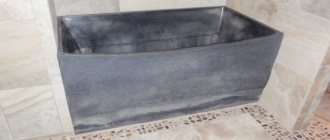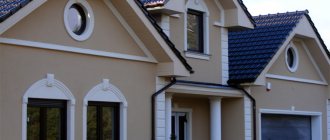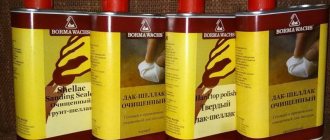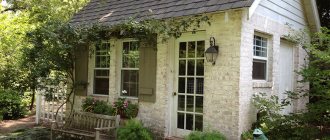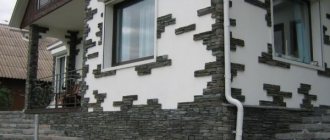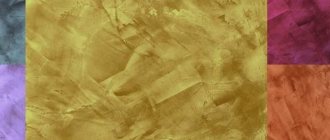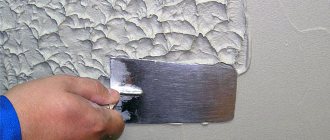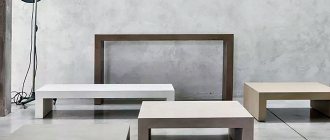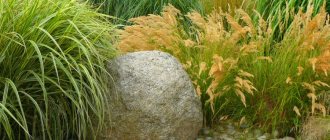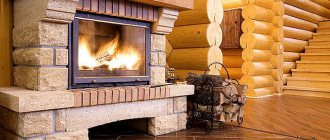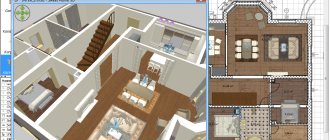Technoblok fixed formwork is a decorative permanent formwork. Thus, construction from Technoblocks is a monolithic method of constructing houses using permanent formwork combined with facing plates.
Permanent formwork consists of modules, technoblocks, but what is it?
What is permanent formwork technoblock
The standard permanent formwork technoblock consists of two facing plates, the overall dimensions of which are 1000x400x30 mm, made of decorative concrete, the so-called “cast marble”. Decorative concrete can have different colors and textures. A sheet of effective insulation - expanded polystyrene - is attached to the outer plate with a layer of 50 mm, 100 mm, or 150 mm, depending on the requirements for the thermal characteristics of the building. The technoblock is equipped with rigid plastic polystyrene ties to ensure that its shape is not disturbed during formwork assembly and concreting.
The design also includes metal hooks made in the shape of the letter L for coupling with the screed. There remains internal free space between the plates for subsequent filling with concrete mortar. After concrete is poured and hardened, a strong supporting structure is formed. The thickness of the concrete layer in the standard technoblock formwork varies from 150 mm (the total thickness of the wall with cladding will be 260 mm) to 250 mm. The thickness of the wall can be increased by using larger hooks and additional ties.
The internal formwork plate is designed not only as a facing plate, but also as a removable one, intended for repeated use. In this case, it is made of moisture-resistant plywood, 21 mm thick. This decorative formwork technoblock is called technoblock combi.
Types of permanent decorative formwork
| Options for technological blocks of decorative permanent formwork | What is facing formwork? |
| Technoblock standard is used for the construction of insulated plinths and walls and double-sided cladding. The insulation is located outside the future reinforced concrete wall. | |
| Technoblock-combi - can be used for the construction of plinths and insulated load-bearing walls. The combi technoblock has decorative cladding on only one side. | |
| Removable technoblock formwork has a wide range of uses. In essence, this is ordinary removable formwork. It allows you to build perfectly smooth load-bearing walls, foundations, plinths, and fences. This is a variant of quick-assembled formwork, which requires few elements to assemble. | |
| Technoblock without insulation is used for the construction of plinths, columns, fences, load-bearing walls with cladding. |
how much are ebony sex doll?
In his own house, a king is a king, says an ancient Spanish proverb. A person wants to feel comfort and safety in his home, which is why he always strives to choose the best and most reliable construction technologies. Why, speaking about modern construction methods, would I like to highlight the technoblock? This technology of monolithic construction of houses compares favorably with competitors in many respects. By the way, the technoblock was developed and patented in Russia, and has already proven itself in the most positive way.
Technoblock in detail: characteristics and design of the technoblock
The technoblock consists of several layers: on the outside we see a facing material, the thickness of which is 3 centimeters, behind which lies the insulation - non-flammable polystyrene foam 5 centimeters thick. The inner plate is removable. The space of 15 centimeters between it and the insulation is reinforced and filled with concrete, which ensures high structural strength. The seismic resistance of houses made of technoblock allows them to withstand magnitude 9 earthquakes. In this construction technology, adhesive parts were completely abandoned, replacing them with fasteners.
Building a house from a technoblock: easy and relaxed
The construction of houses from a technoblock does not require special knowledge or special construction tools, which is also why the technology has become so widespread. It’s really quick to build - since the strong monolithic frame of the house has its own spatial rigidity, additional reinforcements such as cores, reinforced belts, lintels, etc. are not required.
What else does the technoblock allow you to save on?
And here we return to the beginning of the article. Where do those 45% benefits come from when using this construction technology? You save on facade finishing, because the decorative cladding with artificial stone is formed simultaneously with the construction of the load-bearing wall. Another costly expense is the installation of hidden communications. Electricity, ventilation ducts—communication ducts can be installed in the formwork before concrete is poured, saving you from labor-intensive and expensive manipulations in the future. The standard size of the technoblock is 100×40 centimeters. Relatively large modules with standard dimensions greatly facilitate and speed up work. For example, just two people will build the walls of a two-story house from a technoblock in less than two months.
Advantages of technoblocks (decorative formwork)
Reusable formwork plates provide maximum economic effect during construction. They are required much less than facing ones. After such plates are removed, a smooth and even wall surface remains, ready for finishing. Such plates are used for the construction of partitions or internal walls. With their help, subfloors and ceilings are arranged.
Minslab is sometimes used as insulation instead of polystyrene foam. The technoblock is assembled from two formwork plates on a special stand. Next, the first row of Technoblocks is installed on the foundation. checking the horizontal and vertical installation using a building level. After installation, concrete is poured into the internal cavity of the Technoblocks. The next day, another row is installed and concrete is poured. Reinforcement, engineering communications, and embedded elements for technological holes are installed in the internal space of the formwork in the right places.
Construction news
Viessmann: simplifying heating and hot water circuits
At the beginning of February 2021, as part of the business program of the international exhibition Aqua-Therm, a symposium “Efficient heating systems in combination with renewable energy sources” was held, organized by the German Association of Heating Equipment Manufacturers.
KNAUF is developing the direction of modular construction
The KNAUF Group, one of the world's largest manufacturers of construction and finishing materials, continues to implement a project to create systems for modular housing construction. The technology is based on the use of ready-made elements - modules, which can significantly speed up the process of building construction.
Redverg brings open type inverter generators to market
Circular saw from Makita
Makita launches the CA5000XJ circular saw for cutting grooves in aluminum composite panels (also often called Alucobond).
"INTERSKOL": the birth of a new cluster
A year ago, the Russian company opened a new plant in the Special Economic Zone “Alabuga” (Republic of Tatarstan).
Shower System Rain
System Rain is not just a shower, but a real tropical shower in your home!
Source
pros
The technoblock is highly wear-resistant and immune to weather changes and other natural factors. Taking this into account, the material can be installed in the facade system. Technoblock is most often used as one of the layers of exterior finishing.
In addition, basalt wool is not afraid of rodents. Other biological factors, including mold and mildew, will not harm it. The technoblock does not create conditions suitable for their development. As a result, the finishing will retain its original appearance and performance qualities, and will also reduce the risk of rotting and premature wear of other materials used in cladding facades or ceilings.
Basalt wool is easy to process. This does not require special tools; the material is cut using a knife. The blocks can be given any shape; there is no standard: the main thing is that the elements fit together.
Alternative materials
As an alternative to basalt wool, polystyrene foam is often used. It allows the construction of structures at high speed, but has a number of disadvantages. First of all, polystyrene foam absorbs moisture in large quantities. This leads to a deterioration of the microclimate inside the building.
The material is also subject to combustion. Although the manufacturer claims that polystyrene foam is made only from non-flammable types of foam, it is better not to take risks and use finishing only where the risk of fire is minimal.
The real competition for Technoblock comes from materials produced under the brands Rockwool, Ecobasalt, PAROC and ISOROC. This is also mineral wool, but made by other manufacturers. Imported brands of such cladding have a number of advantages over Technoblock; domestic brands are significantly inferior to it in some respects.
What buyers say
This section has collected several reviews from those who have already used the material in their home or had it insulated to order. Perhaps you will find their opinions useful.
Density 45 kg per cubic meter differs from 35 Rockwool LIGHT BUTTS. The cost of both is in a similar range Alexey
I enjoyed working with the material. I used it in frames, both hundred and fifty. Keep in mind that it compresses a little worse than the Optima; it has a density of 35. And one more thing: if the space between the racks is less than 580 millimeters, you may have to trim it. Yuri
A standard Technoblock should have a density of 40–50 kg per cube, and most often 40–42, the minimum is used. I personally have not seen quality certificates with greater density. Well, at least I’m talking about the Yurginsky plant, I don’t know about the others. Plus, keep in mind that they add slag, unlike Rockwool, so in the end the slabs look darker and the melt pellets inside are visible. And this is not only an external joke, but also improves thermal conductivity. So, at similar prices, I would still take Rockwool. Sergey
So, we have highlighted the main characteristics, reviews and descriptions of TechnoNIKOL Technoblock Standard and its “brothers”. Now you have all the information you need to make a decision about the type of insulation.
Variety of forms, names, properties
The range and added properties of products are constantly growing, many new names and brands have appeared, derived from the names of the manufacturer or from the properties of the materials: Warm House, Durisol, polystyrene foam block, Arbolit, Tekolit, eco-blocks, Thermohouse, Lego blocks - the list can be continued significantly.
Remembering and studying the features of each brand or type of formwork is simply inaccessible to a non-specialist, which is why very often people call all these products “Technoblocks”.
Advantages, common and main for all types
Each product has its own characteristics, advantages and disadvantages, but several practical parallels can be drawn for all products, which are very important for individual developers:
- all types of permanent formwork blocks are understandable and easy to use in practical construction, even for novice developers; the products do not require significant skills and experience;
- one of the main characteristics of the products is light weight, which allows you to build your own house or other structure yourself, that is, save quite a lot of money on paying hired workers;
- during independent construction, it is very difficult to build low-quality walls and foundations from carefully designed block structures;
- the price of formwork structures is slightly higher than conventional building blocks, but the total cost is one and a half to two times lower, since there are large savings on insulation and finishing work;
- a monolithic wall structure made of lightweight materials and filled with high-quality concrete mixture is stronger and more durable than a similar structure made of solid blocks for conventional purposes;
- an individual developer usually does not have skills in all construction specialties: carpenter, mason, plasterer, painter, tiler, but with the use of permanent formwork structures, he can successfully avoid a number of works and technologies of traditional construction.
You should not focus only on the cost of blocks.
When independently drawing up estimates or simply preliminary cost calculations, the main attention should be paid to the most important criteria for the developer - reducing labor costs when constructing a house independently and reducing technologically incomprehensible work.
Consider substitution and selection options
It is advisable to take into account the possibility of replacing additional components of Technoblocks with equivalent quality with cheaper analogues, for example:
- replace the foam insulation with a basalt mineral slab,
- additional decorative facing layer of the wall block - for simple painting;
- Instead of heavy ready-mixed concrete, use lighter and cheaper expanded clay concrete to fill the formwork.
When choosing a particular manufacturer, you need to pay attention not so much to the popularity of the brand, but to the reality of the price, innovation and practicality of the product design.
Composition and features of Technoblock products
To produce thermal insulation products, the company uses minerals of the basalt group. Increasing the environmental friendliness of products is facilitated by reducing the amount of binding organic substances in the composition of the boards. Thanks to the chaotic interweaving of fibers, Technoblock insulation absorbs 80-90% of the acoustic signal. It is popular when creating a soundproof barrier for frame walls and partitions.
The mineral base makes the material non-flammable and resistant to chemicals. Microorganisms, mold and rodents do not spoil the thermal insulation layer. The products are designed for a wide range of temperature fluctuations from −60º to +200º C. They do not change the working properties and do not have harmful emissions; melting of the fibers begins at 1000º C.
Moisture resistance is a necessary condition for high-quality insulation of external walls, therefore, during the production process, special additives are included in the slabs to promote hydrophobization.
Fiber boards are characterized by high elasticity; they are easily compressed before being packaged in plastic film, and when opened, they quickly return to their original shape. The material is easy to cut with scissors and easy to install.
Conventional formwork: complexity of execution and numerous technological operations
Carrying out monolithic concrete work using conventional formwork involves the following stages of work:
- Manufacturing of panels from boards or sheet materials fixed to a frame.
- Installation of formwork with leveling into a single structure.
- Strengthening the walls from the outside with special supports to prevent the walls from expanding when pouring concrete.
- Pulling parallel panels together to accurately adjust the thickness of a wall or foundation.
- Coating the internal surfaces of walls to prevent concrete from sticking to them with oil compounds or upholstery with film materials for the same purpose.
- After the concrete has set: dismantling the structure, cleaning from adhesion, minor repairs, re-installation until the required height is reached.
- Refinement of walls with cleaning of irregularities, covering up chips, cracks and potholes that occur at joints and during dismantling of formwork panels.
- Carrying out plastering and painting work.
- Installation of additional insulation, noise absorption, vapor barrier, water absorption, decoration, cladding of a concrete monolithic surface.
Professional insulation
For the most severe operating conditions, Technoblock Prof. is used.
The density of the insulation is 60–70 kg per cubic meter. And the compression ratio is only 5%. And yet, this material is a semi-rigid mineral wool board. This must be taken into account when choosing this type of insulation.
Technoblock Prof is a semi-rigid mineral wool board
Prof comes in thicknesses from 50 to 150 mm. All types of slabs are shown in the table.
So, we saw that the main differences between the three types of this material are in density, that is, rigidity.
Below is a comparison table of characteristics
| Type of characteristics | |||
| TECHNOBLOCK STANDARD | TECHNOBLOCK OPTIMA | TECHNOBLOCK PROF | |
| Density, kg/m3 | 45 ± 5 | 50-60 | 60-70 |
| Compression % no more | 10 | 8 | 5 |
| Thermal conductivity at 10°C, W/(m°C) no more | 0.034 | 0.034 | 0.033 |
| Thermal conductivity at 25°С, W/(m°C) no more | 0.036 | 0.036 | 0.035 |
| Thermal conductivity under operating conditions A, W/(m°C) no more | 0.043 | 0.041 | 0.04 |
| Vapor permeability, mg/(m.h.Pa) not less | 0.3 | 0.3 | 0.3 |
| Humidity at weight % no more | 0.5 | 0.5 | 0.5 |
| Water absorption at volume % no more | 1.5 | 1.5 | 1.5 |
| Content of organic substances % no more | 2.5 | 2.5 | 2.5 |
| Flammability | NG | NG | NG |
Does this insulation have any disadvantages? Alas, where would we be without them? Let's highlight two main ones:
Basic physical and mechanical characteristics of the material
Plates made from basalt fibers are characterized by strength and elasticity. They are designed for operation at low and high temperatures, which expands the possibilities of using the material. Insulation is recommended for private and civil construction.
Main technical characteristics of the blocks:
- thermal conductivity – 0.035-0.039 W/(m*K);
- compressibility – from 5 to 10%;
- vapor permeability – 0.3;
- water absorption – up to 1.5% by volume;
- content of organic substances – 2.5%;
- flammability group - NG.
Product parameters:
- length – 1000, 1200 mm;
- width – 400, 500, 600, 1000 mm;
- thickness – 30-200 mm.
The dimensions of the slabs are standard; they are the same for all types of insulation produced.
